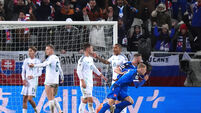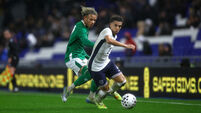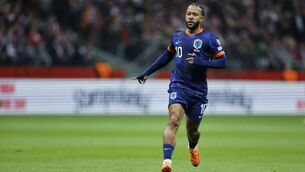A challenge in a league of its own
The two men have recently been installed to key positions in the new eircom League of Ireland. Gavin, formerly the General Secretary of the Professional Footballers’ Association of Ireland, is the new director of the League while former Cork City, Limerick and Shamrock Rovers ‘keeper Mooney has been appointed National Club Promotions Officer, with a brief which essentially boils down to reviving interest in the domestic game — or, to use the vernacular, putting more bums on seats.
At their first press conference in Merrion Square, the two men did a fine job of accentuating the positive and painting the picture of a league which can once more attain a status more substantial than the equivalent of a cult following in Irish sport.
If you could bottle the enthusiasm of these two devotees of the local game and sell it on the terraces, the fans wouldn’t be long coming back for the same again, please.
Nevertheless, if they need any reminding of the size of the challenge which faces them, they could do worse than leaf through one of the sports books of the year, journalist Daire Whelan’s ‘Who Stole Our Game?’ (Gill & Macmillan), a forensic examination of what the subtitle bluntly calls ‘The Fall And Fall Of Irish Soccer’.
As a handy one-stop-shop for all the things which have ailed the domestic game down the years, this catalogue of doom and gloom is close to definitive. All the depressing milestones are here: the demise of Drumcondra FC, the sale of Milltown, the Paul Marney
affair, dwindling attendances, bad administration, financial problems, bitter in-fighting and not forgetting that almost Pythonesque period when Irish club football found itself saddled with the name, The Famous Fried Chicken League of Ireland.
Elements of the answer to the question posed by the book’s title are contained in analysis of all these events and more, but sometimes it’s the pictures which speak even louder than the words.
There, in nostalgic black and white, is a photo Drumcondra FC playing in front of a massive crowd in the early 60s, the palpable drama contrasting starkly with the colour cover image from more recent times of three men standing on a terrace otherwise populated solely by a profusion of weeds.
The era of Drums seems to belong to antiquity now but, in truth, we are talking Tolka Park not Jurassic Park. Your own correspondent, though happily still a long way off pensionable age — despite appearances — can even recall owning a Drums Subbuteo table football team in his youth. Fact! Admittedly, I pressed them into action mainly to act as cannon fodder for my miniature but mighty Hoops, in between regular big nights in Europe when the latter would somehow always manage to edge Man United or Real Madrid 4-3 while a tiny Phillip Greene swan-dived off his commentary perch in sheer joy.
In fact, having begun attending Milltown on a regular basis as the 60s morphed into the 70s, I’m sad to say that I can retrospectively claim a ringside seat at almost the precise moment when the great League of Ireland wave finally crashed.
Daire Whelan also marks it in his book. The appearance of BBC’s Match Of The Day in 1964 was a harbinger of what was to come and the axe finally began to fall in 1968 when ITV launched ‘The Big Match’ on Sunday afternoons. That was the year that Rovers and Waterford attracted a crowd unofficially estimated at around 45,000 to the FAI Cup final in Dalymount. But within just a few years, myself and my mates would have huge chunks of the terrace all to ourselves, even when big guns of the time like Alfie Hale’s boys or Cork Hibs or Dundalk visited Milltown.
There’s no mystery in this. As Daire Whelan points out: “The bottom line was that English football was just so damn seductive...It’s safe to say that no two programmes prior to the arrival of Sky Sports have had such a detrimental impact on Irish sport.”
Add in the allure of a revitalised Dublin GAA team and the attendant phenomenon of Heffo’s Army, and League of Ireland football was forced to begin fighting a desperate rearguard action which continues today.
In a sense then, nobody stole the game at all: the fans simply rejected it in favour of something else, something even more glamorous than the likes of Leech and O’Neill and Richardson in their pomp.
But Daire Whelan is still entitled to indict those in positions of power who, whether by acts of commission or omission, contrived over the years to make a bad situation worse. And, because of his publication deadline, he doesn’t even get the opportunity to reflect on yet another season of many woes off the pitch, with the demise of Dublin City, smouldering rows over disputed points, the promotion game that wasn’t, and the deeply disturbing spectacle of players from champions Shelbourne failing to get their wages on time.
And yet it’s in the nature of the beast that hope always springs eternal. (Rovers are back where they belong, for a start, if not yet in a place they can call home). Full-time professionalism, when clubs can really afford it — and even, it seems, when they can’t — has reaped dividends on the pitch, as witnessed by the excellent performances of Derry City and Drogheda United in Europe. And, when the grounds are hopping for a big game, there are few better places to watch good football than in Turner’s Cross or the Brandywell, creating that special atmosphere which television can never hope to replicate.
The job of all those involved with the new lLeague is to do everything they can to make those occasions the norm rather than the exception. It’s a tall order, and the likes of Fran Gavin and Noel Mooney deserve our best wishes this festive season — and, more crucially, our support in the long season to come.














